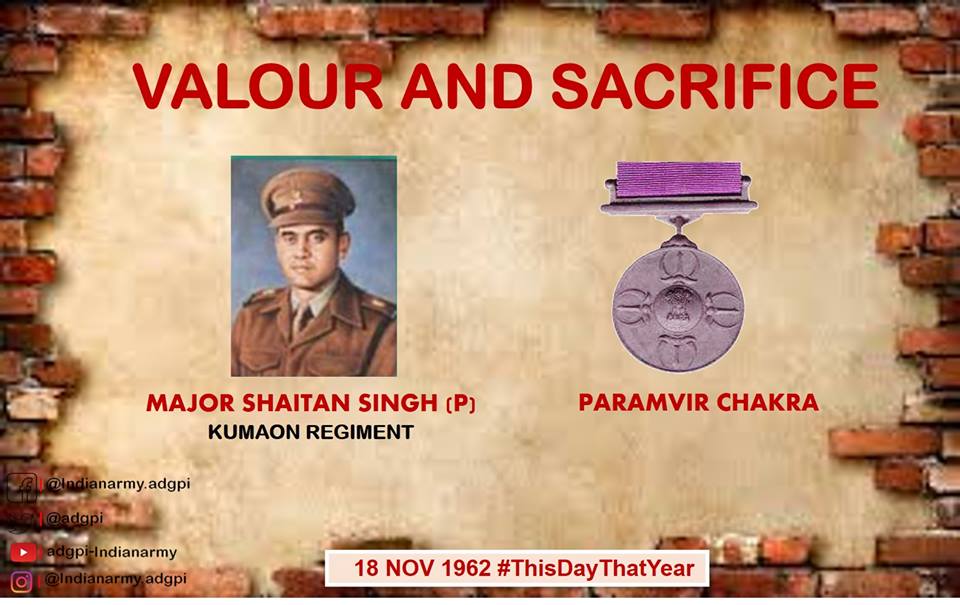Story Of Ultimate Sacrifice: The Epic Battle of Rezang La :
Major Shaitan Singh – The unforgettable Hero of Indo-China war
18/11/2017
Story Of Ultimate Sacrifice: The Epic Battle of Rezang La :
Chinese Invasion / Aggression -1962
Indian Army
Defense News
In the winter of 1962, invading Chinese troops made a bold statement when they decided to venture and capture deep Indian Territory at the height of the Sino-Indian war. With every passing hour, the Chinese aggression on the Indian side was increasing in intensity and something needed to be done to at least put a temporary end to the Chinese advances across the Indian territory. And this is when they decided to attack and capture Rezang La in Ladakh.
Rezang La pass is located at around 16000 feet near Chushul. Commonly also known as Ahir Dham because of the local inhabitants’ Ahirs, the pass was one of the most critical nerves held by the Indian army in Ladakh, one whose cessation to the Chinese would mean total surrender by the Indian army. In that context, when the Chinese troops attacked Rezang La, not only did they attack a major Indian post but also struck a heavy blow on the Indian Army ego.
*
The Battle of Rezang La -1
The Charlie Company of the 13th Kumaon regiments was led by the legendary Major Shaitan Singh Bhati. Stationed at Rezang La with 120 men under him, Shaitan Singh took the bull by its horn and decided to hold ground against hordes of Chinese attacking under heavy artillery fire from the Chinese side. The Indian side, however, couldn’t hope for a defending artillery fire as it was situated behind a hill feature thus leaving the 120 brave men to fend for themselves.
The first attack from the Chinese came from the Nullah, a dry river bed, and was successfully thwarted by the Charlie Company with the help of the machine gun. The Chinese didn’t expect such strong retaliation from the Indian side and regrouped to launch a second attack which almost eclipsed the first one by a ratio of 3:1. This too was well defended by the boys of the Charlie Company.
*
The Battle of Rezang La -2
But Shaitan Singh knew that he couldn’t sustain it for too long because the next Chinese attack would overwhelm his brave men even if they stood their ground in case of a total rout. He moved from one post to another to motivate his squad and asked for their ultimate sacrifice in the name of their motherland. And they did.
On that day, 114 of the 120 odd jawans lost their lives in ultimate last stand and service to the nation. There have been many estimates as to how many Chinese men were killed which range from 500-2000. When the bodies of the Indian men were fetched, many of them were still holding onto a bomb. A medical help was found with a syringe and bandage in his hands. This meant that the attack was on from the Indian side when many of the posts were overrun by the Chinese, meaning the Indian men didn’t leave their posts till they were physically confronted by the enemy and still died on the field with bombs in their hands.
*
The Battle of Rezang La -3
General K.S Thimayya, one of the most recognized soldiers of the Kumaon regiment who served as the Army chief once said this about the battle of Rezang La: “You rarely come across such example in the annals of world military history when braving such heavy odds, the men fought till the last bullet and the last man. Certainly, the Battle of Rezang La is such a shining example.”
Brig (later Gen) TN Raina, MVC
According to those who visited Rezang La, three months later:-“The dead men were found in their trenches, frozen stiff, still holding their weapons. Broken Light Machine Gun bipods, and some men holding only the butts of their rifles while the remaining weapon had blown off, bore witness to the enemy fire.”
Major Shaitan Singh was commanding a Company of 13 Kumaon deployed at Razang La in the Chushul Sector at height of about 17,000 feet. On 18 November 1962, the Chinese subjected the company position to heavy artillery, mortar and small arms fire and attacked in overwhelming strength in successive waves. Major Shaitan Singh moved from post to post motivating men at a great personal risk, constantly boosting the morale of his hard-pressed platoon posts. During the course, he was seriously wounded however, he continued to encourage and lead his men who, following his brave example, fought gallantly and inflicted heavy casualties on the enemy. Major Shaitan Singh inspite of being incapacitated with multiple wounds, chose to fight till last bullet. For his indomitable courage, outstanding leadership and exemplary devotion to duty, Major Shaitan Singh was posthumously awarded
*
Major Shaitan Singh, who died motivating his company, became only the second winner of the Param Vir Chakra which was awarded to him posthumously. Other fighters who were awarded the Veer Chakras included Naik Hukum Chand (posthumous), Naik Gulab Singh Yadav, Lance Naik Ram Singh (posthumous), Subedar Ram Kumar and Subedar Ram Chander. In the end, Shaitan Singh and his men proved that no matter what the odds, some battles are just worth dying for.
*
Memorial :-
which reads as
How can a Man die Better than facing Fearful Odds,
For the Ashes of His Fathers and the Temples of His Gods,
To the sacred memory of the Heroes of Rezang La,
114 Martyrs of 13 Kumaon who fought to the Last Man,
Last Round, Against Hordes of Chinese on 18 November 1962.
Built by All Ranks 13th Battalion, The Kumaon Regiment.
***











Comments
Post a Comment